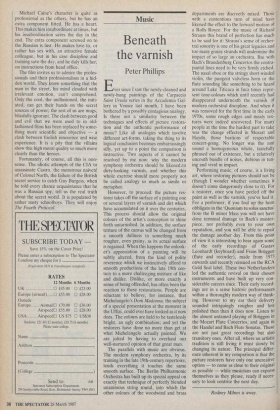Music
Beneath the varnish
Peter Phillips
Ever since I saw the newly-cleaned and newly-hung paintings of the Carpaccio Saint Ursula series in the Accademia Gal- lery in Venice last month, I have been bothered by a possibly contagious analogy. Is there not a similarity between the techniques and effects of picture restora- tion and the authentic performance of music? Like all analogies which involve different art-forms, taking the thing to its logical conclusion becomes embarrassingly silly, yet up to a point the comparison is instructive. Two aspects of it cannot be resolved by me now: why the modern symphony orchestra should be likened Eto dirty-looking varnish, and whether this whole exercise should more properly not be called analogy so much as simile or metaphor.
However, to proceed: the picture res- torer takes off the surface of a painting one or several layers of varnish and dirt which have accumulated on it over the centuries. This process should allow the original colours of the artist's conception to shine forth untarnished. In addition, the surface texture of the canvas will be changed from a smooth dullness to something much rougher, even grainy, as its actual surface is regained. When this happens the onlook- er's appreciation of a painting will be subtly altered, from the kind of polite reverence which we instinctively afford to smooth productions of the late 19th cen- tury to a more challenging mixture of like and dislike. DiSlike, or more exactly a sense of being offended, has often been the reaction to these restorations. People are reluctant to believe, for instance, that Michelangelo's Doni Madonna, the subject of a special presentation at the moment in the Uffizi, could ever have looked as it now does. The colours are held to be tastelessly bright, an ugly combination; and yet the restorers have done no more than get at what Michelangelo actually painted. We are jolted by having to overhaul our well-nurtured opinion of that great man.
The parallels with music are obvious. The modern symphony orchestra, by its training in the late 19th-century repertoire, lends everything it touches the same smooth surface. The Berlin Philharmonic Orchestra has built up its special appeal on exactly that technique of perfectly blended unanimous string sound, into which the other colours of the woodwind and brass departments are discreetly mixed. Those with a contentious turn of mind have likened the effect to the forward motion of a Rolls Royce. For the music of Richard Strauss this brand of perfection has much to be said for it: Strauss's sense of orches- tral sonority is one of his great legacies and too many grainy strands will undermine the impact of so large an orchestra. But with Bach's Brandenburg Concertos the contra- puntal lines need to be very firmly etched. The nasal oboe or the stringy short-winded violin, the pungent valveless horn or the flute sounding like something to be heard around Lake Titicaca in Inca times repre- sent tone-colours which until recently had disappeared underneath the varnish of modern orchestral discipline. And when it was removed for the first time in the early 1970s, some rough edges and mealy tex- tures were indeed uncovered. For many people at the time the hardest part to take was the change effected in Mozart and Haydn, those bastions of respectable concert-going. No longer was the tutti sound a homogeneous whole, tastefully phrased out of existence, but a relatively uncouth bundle of noises, dubious in tun- ing and vivid in impact.
Performing music, of course, is a living art, where restoring pictures should not be (though I wonder whether sometimes it doesn't come dangerously close to it). For a restorer, once you have peeled off the paint as well as the varnish, you've had it. For a performer, if you foul up the horn obbligato in the `Quoniam tu solus sanctus' from the B minor Mass you will not have done terminal damage to Bach's master- piece, nor probably even to your own reputation, and you will be able to repair the damage another day. From this point of view it is interesting to hear again some of the early recordings of Gustav Leonhardt (keyboard) and Frans Briiggen (flute and recorder), made from 1973 onwards and recently reissued on the RCA Gold Seal label. These two Netherlanders led the authentic revival on their chosen instruments and have built up very con- siderable careers since. Their early record- ings are in a sense historic performances within a thoroughly modern way of think- ing. However to my ear their delivery sounded intriguingly rougher and less polished then than it does now. Listen to the almost untamed playing of Briiggen in the Mozart Flute Concertos, and again in the Handel and Bach Flute Sonatas. These are not just great recordings but also transitory ones. After all, where an artistic tradition is still living it must slowly be changing its nature. The principal differ- ence inherent in my comparison is that the picture restorers have only one uncreative option — to come as close to their original as possible — while musicians can express themselves as they please, ready if neces- sary to look contrite the next day.
Rodney Milnes is away.


















































 Previous page
Previous page